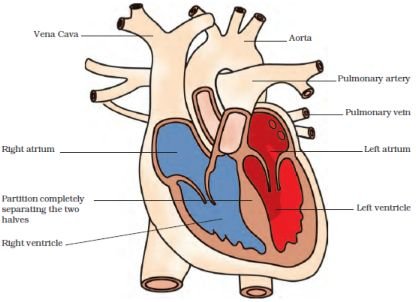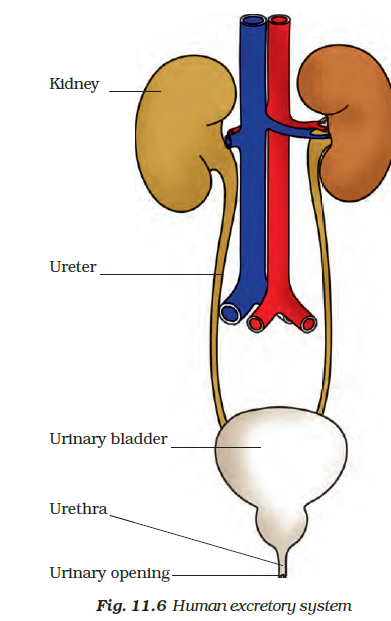NCERT Solutions Class 7 Science
The NCERT Solutions in English Language for Class 7 Science Chapter – 11 (Transportation in Animals and Plants) has been provided here to help the students in solving the questions from this exercise.
Chapter – 11 (Transportation in Animals and Plants)
1. Match structures given in Column I with functions given in Column II.
| Column – I | Column – II |
| (i) Stomata | (a) Absorption of water |
| (ii) Xylem | (b) Transpiration |
| (iii) Root hairs | (c) Transport of food |
| (iv) Phloem | (d) Transport of water |
| (e) Synthesis of carbohydrates |
Answer –
| Column – I | Column – II |
| (i) Stomata | (b) Transpiration |
| (ii) Xylem | (d) Transport of water |
| (iii) Root hairs | (a) Absorption of water |
| (iv) Phloem | (c) Transport of food |
2. Fill in the blanks.
(i) The blood from the heart is transported to all parts of the body by the _____________ .
(ii) Haemoglobin is present in _____________ cells.
(iii) Arteries and veins are joined by a network of _____________ .
(iv) The rhythmic expansion and contraction of the heart is called _____________.
(v) The main excretory product in human beings is _____________.
(vi) Sweat contains water and _____________ .
(vii) Kidneys eliminate the waste materials in the liquid form called _____________ .
(viii) Water reaches great heights in the trees because of suction pull caused by _____________ .
Answer –
(i) The blood from the heart is transported to all parts of the body by the arteries.
(ii) Haemoglobin is present in red blood cells.
(iii) Arteries and veins are joined by a network of capillaries.
(iv) The rhythmic expansion and contraction of the heart is called heartbeat.
(v) The main excretory product in human beings is urea.
(vi) Sweat contains water and salts.
(vii) Kidneys eliminate the waste materials in the liquid form called urine.
(viii) Water reaches great heights in the trees because of suction pull caused by transpiration.
3. Choose the correct option:
(a) In plants, water is transported through
(i) xylem
(ii) phloem
(iii) stomata
(iv) root hair
Answer – (i) xylem
(b) Water absorption through roots can be increased by keeping the plants
(i) in the shade
(ii) in dim light
(iii) under the fan
(iv) covered with a polythene bag
Answer – (iii) under the fan
4. Why is transport of materials necessary in a plant or in an animal? Explain.
Answer – The cells of different organs of plants and animals need various necessary substances to carry out many metabolic activities and different type of waste products are created during these metabolic activities. So, transport of materials is necessary to supply the required substances and to remove the waste products.
5. What will happen if there are no platelets in the blood?
Answer – If there are no platelets in the blood, then the blood would not be able to clot. A clot is formed because of platelets. They release blood clotting chemicals at the site of injury. These chemicals form a clot and prevent further bleeding.
6. What are stomata? Give two functions of stomata.
Answer – Stomata are tiny pores present on the surface of a leaf.
Functions of stomata:
(a) Stomata help in the exchange of gases.
(b) Evaporation of water from the leaf surface occurs through stomata.
7. Does transpiration serve any useful function in the plants? Explain.
Answer – Transpiration serves a very important function in plants. It is the loss of water through stomata. Transpiration creates the transpiration pull, which is responsible for the rise of water to great heights in tall plants and other trees.
8. What are the components of blood?
Answer – There are four components of blood:
- Plasma is a liquid part of blood which is yellowish in colour and contain 90% water. It contains food, enzymes, wastes and proteins etc.
- Red blood cells are disc shaped cells containing red coloured pigment called haemoglobin in it. Haemoglobin helps in transportation of oxygen.
- White blood cells are the fighting cells which protect us against bacteria and foreign materials causing infections.
- Platelets help in clotting of the blood
9. Why is blood needed by all the parts of a body?
Answer – Blood is needed by all parts of the body as it is an important part of the transport system of our body. It performs the following important functions:
- It transports O2 from the lungs to all the body cells.
- It carries CO2, a waste product back to the lungs so that it can be exhaled easily.
- It transmits heat, thus regulating the body temperature.
- It also fights off diseases and infections.
10. What makes the blood look red?
Answer – The presence of haemoglobin, a red pigment in the red blood cells (RBCs) makes blood appear red in colour. The haemoglobin carries oxygen and transports it to all the parts of the body.
11. Describe the function of the heart.
Answer – The right auricle and ventricle receive blood with carbon dioxide from all parts of the body. The collected blood is then pumped to the lungs for the purification. In lungs, the exchange of gases takes place and purified blood is sent back to left auricle. It pumps it to the left ventricle, which in turn pumps off the purified blood to all parts of body through arteries

12. Why is it necessary to excrete waste products?
Answer – All cells of our body produce waste products. These waste products are toxic to the body and therefore need to be excreted out. This process of removing waste products produced in the cells of living organisms is called excretion.
13. Draw a diagram of the human excretory system and label the various parts.
Answer –


Leave a Reply